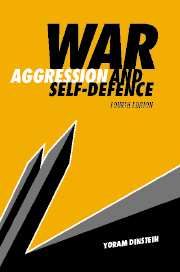Book contents
- Frontmatter
- Contents
- Introduction to the fourth edition
- From the introduction to the first edition
- Table of cases
- Table of treaties
- Table of security council and general assembly resolutions
- List of abbreviations
- Part I The legal nature of war
- Part II The illegality of war
- 3 A historical perspective of the legal status of war
- 4 The contemporary prohibition of the use of inter-State force
- 5 The criminality of war of aggression
- 6 Controversial consequences of the change in the legal status of war
- Part III Exceptions to the prohibition of the use of inter-state force
- Conclusion
- Index of persons
- Index of subject
3 - A historical perspective of the legal status of war
- Frontmatter
- Contents
- Introduction to the fourth edition
- From the introduction to the first edition
- Table of cases
- Table of treaties
- Table of security council and general assembly resolutions
- List of abbreviations
- Part I The legal nature of war
- Part II The illegality of war
- 3 A historical perspective of the legal status of war
- 4 The contemporary prohibition of the use of inter-State force
- 5 The criminality of war of aggression
- 6 Controversial consequences of the change in the legal status of war
- Part III Exceptions to the prohibition of the use of inter-state force
- Conclusion
- Index of persons
- Index of subject
Summary
The ‘just war’ doctrine in the past
The Roman origins
The distinction between ‘just war’ (bellum justum) and ‘unjust war’ (bellum injustum) can be traced back to the jus fetiale. This body of law existed in ancient Rome, from the days of the kings until the late republican era. The fetiales were a college of priests charged with a number of duties, some of which pertained to the inception of war.
Cicero stated that it may be gathered from the code of the fetiales that no war is considered just, unless it is preceded by an official demand for satisfaction or warning, and a formal declaration has been made. It follows that two indispensable conditions of a procedural nature had to be met before the commencement of hostilities. The first requisite was that a demand be addressed to the opponent, insisting on satisfaction for the grievance caused to Rome (such satisfaction taking the form of restitution, withdrawal of forces, etc.), with a fixed time allowed for a proper response. The second condition was that a formal declaration of war had to be issued. The declaration entailed an elaborate ceremony, culminating in a spear being hurled across the Roman frontier into the enemy's territory, and including the recital of ancient legal formulas recorded in detail by Livy.
- Type
- Chapter
- Information
- War, Aggression and Self-Defence , pp. 63 - 82Publisher: Cambridge University PressPrint publication year: 2005



